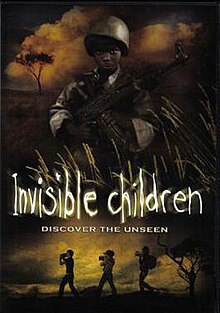Invisible Children: Difference between revisions
Changed title to Invisible Children: Rough Cut |
Tag: references removed |
||
| Line 23: | Line 23: | ||
==Exhibition== |
==Exhibition== |
||
hahaha |
|||
The film was originally screened on June 22, 2004 at the Joan B. Kroc Institute for Peace and Justice at the [[University of San Diego]].<ref>[http://www.sandiego.edu/peacestudies/ipj/events/past_events/2005/02-21-05_invisible_children.php University of San Diego] The Joan B. Kroc Institute for Peace & Justice.</ref> |
|||
In the past six years, the organization has hosted 5,369+ "official" screenings at colleges, high schools, churches, concerts and other venues. As of June 2009, it is estimated that more than 5 million people have seen ''Invisible Children: The Rough Cut.''<ref>[http://www.successmagazine.com/Making-a-Difference-Invisible-Children/PARAMS/article/523/channel/24 Deneen, Sally]. "Making a Difference - Invisible Children Helping young victims in war-torn Africa," Success Magazine, 2010.</ref> Also at one occasion they had 200 cities helping the cause in 10 countries across the world getting one of the boys (the main focus of the film) to travel over there and help to show the government of the impact it made. |
|||
==Social activism== |
==Social activism== |
||
Revision as of 15:08, 7 December 2010
| Invisible Children: Rough Cut | |
|---|---|
 Theatrical release poster | |
| Directed by | Jason Russell Bobby Bailey Laren Poole |
| Music by | Nathan Lanier |
Release date | 2006 |
Running time | 52 minutes |
| Country | United States |
| Language | English |
Invisible Children: Rough Cut is a 2003 American documentary film. Its subject is the abduction and forced enlistment of children by the sectarian Lord's Resistance Army in Uganda.[1]
Synopsis
In the spring of 2003, three filmmakers (Jason Russell, Bobby Bailey, and Laren Poole) travelled to Africa. They produced a documentary that revolves around Africa's longest running war, where children have become weapons. Rebel armies, known as the Lord's Resistance Army (LRA), have been abducting children and using them as troops while they wage war against the Ugandan government. This originally caused the children to night commute, or walk miles nightly to avoid these troops. It is estimated that 90% of the LRA is abducted children. The film tells their story of horror.
Exhibition
hahaha
Social activism
The story of the invisible children sparked a grassroots movement mobilizing thousands of American teens into action to raise money to rebuild war-torn schools in northern Uganda and provide scholarships to African youth.[2]
A 501(c)(3) non-profit Invisible Children, Inc. was created, giving individuals a way to respond to the situation in Uganda.[3] An employee of the organization, Nate Henn, was killed in the July 2010 Kampala attacks.[4]
DVD
The film is roughly 52 minutes long, and includes a shorter 35-minute version for different screening options. Also included on the DVD are special features including deleted scenes, extras, filmmaker commentary, update on the war, and trailers from Invisible Children.[5]
References
- ^ Invisible Children at IMDb
- ^ Wellspring International.
- ^ Take Part web site, 2010.
- ^ "AP Top News at 4:05 a.m. EDT". Associated Press. July 12, 2010. Retrieved July 12, 2010.
- ^ Invisible Children at IMDb
External links
- Invisible Children Homepage
- Invisible Children at IMDb
- Invisible Children images from film
- Mourning Nate Henn the Nate Henn memorial website
